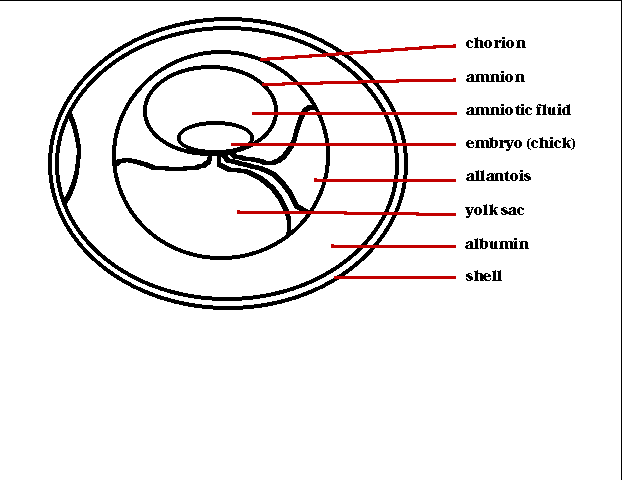
Animals have been laying eggs for millions of years; snails, fish, and many other critters produce eggs from which their young hatch. The egg of the chicken is a special kind of egg. It has a shell to help prevent drying, and a series of membranes that surround the developing chick. This kind of egg is unique to the amniotes, a group that includes turtles, lizards, birds, dinosaurs, and mammals. The last name in that list, the mammals, may have surprised you since most mammals do not lay eggs, but the earliest mammals laid eggs, and a few, such as the monotremes, still do. To understand this, you must first understand....

Inside the egg are a series of fluid-filled membranes which permit the embryo to survive: the amnion, allantois, yolk sac, and chorion. Surrounding and protecting the embryo is the amnion, filled with amniotic fluid, and providing the embryo with a stable fluid environment. The allantois performs two very important functions for the embryo, providing for gas diffusion, and removal of wastes. Food for the developing embryo comes from the yolk sac, which reduces in size as the embryo matures. Surrounding all the other membranes is the chorion, providing an overall enclosure for the young.
Around the chorion is the albumin, or "white" of the egg, and an outer shell protects the whole egg, preventing drying while still permitting air to reach the embryo. An air space, visible at the left of the above diagram, provides an extra internal buffer for environmental conditions.
In the placental mammals the membranes found in the egg have been modified somewhat. The embryo is still surrounded by an amnion filled with amniotic fluid; because it is next to and surrounds the embryo, doctors will sometimes examine the fluid to determine the health of the unborn child. The allantois and yolk sac become the umbilical cord, providing a connection through which food reaches the fetus, and wastes are removed. Together with part of the chorion, these membranes make up the placenta, which physically attaches the embryo to the uterine wall of its mother. It is across the placenta that air, food, and wastes must be transferred. Around the whole is the fluid-filled chorion, which "breaks" as labor begins.
For more informaion, visit Jack Conrad's pages on Amniota.

